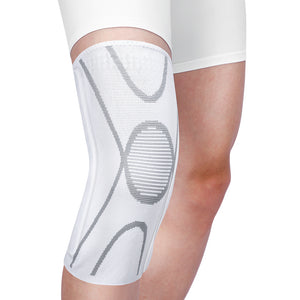How to Fix Pronated Ankles?

Excessive inward rolling of your foot, known as overpronation, can cause a cascade of problems for your feet, ankles, knees, hips, and back.
A pronated ankle is a condition in which your ankle rolls excessively inwards when you walk or run. Let’s dive deeper and learn how to fix pronated ankles after recognizing their symptoms.

Recognizing the Symptoms of Ankle Pronation
According to a study[1] done on 36 individuals, additional foot muscle fatigue occurring while running leads to excessive foot pronation. Don't let ankle pronation sneak up on you. Before uncovering how to fix a pronated ankle, recognize the symptoms of ankle pronation.
Do you or your loved one often complain, "My feet hurt"? It might be related to overpronation.
Look for these signs and symptoms and identify if you have ankle pronation.
- Pain in the arches (plantar fasciitis) and heels
- Swelling along the inside of the ankle
- Uneven wear on the soles of shoes
- Flat feet or collapsed arches
- Unusual tight leg muscles
- Pain in the knees, hips, or lower back
- Frequent ankle sprains or instability
- Calluses or bunions on the big toe
- Shin splints or other lower leg pain
Do not confuse ankle pronation with flat feet (pes planus). Flat feet are a structural condition in which the arch is either absent or it is flattened. In this condition, the entire sole contacts the ground. Both of these conditions differ from each other in terms of underlying causes, and both have different treatments.
There can be a number of causes behind ankle pronation, such as:
- Feet injury
- Weak muscles due to aging or heavy strain placed on the feet
- Standing or walking long hours in high heels
- Wearing shoes that don't provide proper arch support
How to Fix Pronated Ankles?
Over pronation of foot can throw a wrench into your day. It can cause discomfort in your various body parts due to misalignment and increased strain on joints and muscles. But the good news is, overpronation can be corrected. The bad news if it’s left unchecked, it can lead to Plantar fasciitis, stress fractures, and other serious foot issues. Let’s break down how to fix pronated ankles using different approaches.
(1) Exercise and Rehabilitation Training
Just several weeks of foot strengthening exercises have been found to significantly improve foot posture in people with pronated ankles. If you have a foot that rolls in excessively, various exercises and rehabilitation training can be useful. Let's break these exercises into three sections for the most effective results:
- Selective exercises to strengthen the muscles of your foot.
- Specific exercises for controlling the roll of foot
- Arch exercises in more functional positions
There are two muscle groups that control the arch of your foot. Intrinsic muscles are responsible for bringing the arch up. The other muscle group, the tibialis posterior and tibialis anterior muscles, control how much your foot rolls. These muscles come from the calf. To strengthen these muscles, do these exercises:
1. Towel Exercise: Follow these steps to do this exercise:- Take a towel and place it on the floor
- Sit on the chair
- Place your half foot on the towel and half on the floor
- Use your toes to scrunch the towel towards you
Let's face it; it is quite a tedious exercise, as you can do it while sitting in front of your television. Plus, it will not make you sweaty.
2. Toe Yoga: To do this exercise, simply lift your big toe while keeping the other one down. Then put your big toe down, and lift the other toes.3. Tip Toe Walking: Start this exercise with trainers and walk on the toes tips. Later,when you get used to it, you can confidently do it barefoot. This will strengthen the muscles and ligaments of your ankle, foot, and leg.
3. Stretching Exercise: This exercise is great for controlling the roll of the foot.
- Take a thera band and tie it around a chair or a table
- Place the band around your foot
- Cross your legs over the other
- Stretch the band with your foot against resistance and slowly back out
- Repeat this exercise
- Start by standing with a slight knee
- Bend and pull the inside of your foot up so that you are on the outside of your foot but with the tip of the big toe still touching the ground.
- Hold this position for 5 seconds
- Repeat this exercise 5 to 10 times
(2) Shoes and Ankle Brace
A lot of modern footwear has a narrow toe box, and the more pushed in your toes are, the less pronation support you have. So, choosing footwear with a wider toe space will help enormously. Shoes with pronation support, the ones that are stiffer to rotate in the back two-thirds, will help to take pressure off the plantar fascia of the lower legs.
But wearing them all the time makes muscles supporting your arch weaker, and you can become dependent on them. So try to wean yourself off them slowly once you have your symptoms of ankle pronation under control.
Arch-supporting orthotics have been found to reduce maximum heel eversion (a key metric of pronation) by more than 20% in some runners[2]. So, high-quality arch-supporting insoles and orthopedic ankle braces such as Fivali’s ankle guards can be useful assistive tools. Investing in the best brace for a sprained ankle will keep your feet secured and help minimize the symptoms.
(3) Seek medical attention
If you are unsure whether you have pronated ankles or not, it is highly recommended that you consult a podiatrist for a proper diagnosis. They'll also help tell you how to correct overpronation following effective strategies.
The Importance of Prevention
An ounce of prevention is worth a pound of cure, especially when it comes to managing ankle pronation. That's why you should incorporate foot-strengthening exercises into your daily exercise habit. Combine these exercises with high-quality ankle supports such as those from Fivali to keep your feet in proper alignment. Choose an ankle brace for a sprained ankle carefully, as it can be a make-or-break deal for the protection of your ankles.

We hope this article provided some value and helped you learn how to fix pronated ankles. Strengthening exercises like toe yoga, towel scrunches, and tiptoe walking are great for improving foot posture and stability. The ankle braces by Fivali are truly life savers. Fivali just doesn't raise the bar - we set it by offering perfect ergonomic fits. With Fivali fits so comfortable and innovative, you'll forget you're wearing it.
References:
[1] A Short-Term Evaluation of Foot Pronation Tendency in Healthy Recreational Runners. Available at: https://www.ncbi.nlm.nih.gov/pmc/articles/PMC10672250/(Accessed: 25 June 2024)[2] Effect of medial arch-heel support in inserts on reducing ankle eversion: a biomechanics study. Available at: https://pubmed.ncbi.nlm.nih.gov/18289375/ (Accessed: 25 June 2024)













